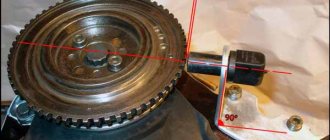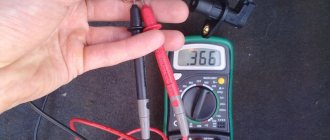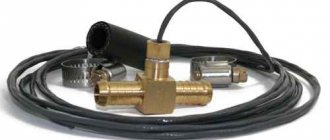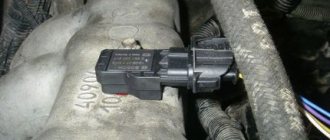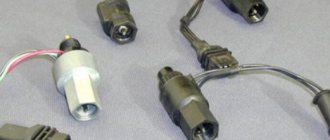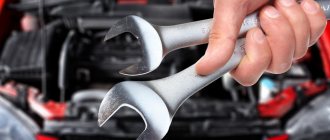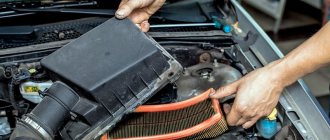Problems in the operation of the DPRV can seriously threaten the safety of the driver and passengers. Imagine the situation: you are driving in heavy traffic in a large city, and suddenly the engine suddenly loses power, which leads to a significant decrease in the speed of your car. Very often it ends in an accident, because the driver driving behind simply does not have time to react.
Another option is that while driving, the engine stalls and the power steering is turned off, which is why you cannot make a sharp turn. The situation is sad and this really happens. In other situations, you simply leave the house to go to work, and the engine does not start at all.
This article will discuss the main symptoms of a DPRV malfunction. You will also learn where the camshaft sensor is located and how to check it yourself. But first, let's try to figure out why it is needed at all.
What is camshaft position sensor (camshaft position sensor)?
The cylinder head of the power unit contains 1-2 camshafts. They are equipped with special blades responsible for controlling the intake and exhaust valves. The block also contains a crankshaft, which drives the camshaft through gears, a timing belt, or a timing chain.
To determine the working cylinder, the engine ECU analyzes the rotating position of the camshaft in relation to the current position of the crankshaft. This is exactly the information that the DPRV reports. The control unit uses the received data to correct the operation of the fuel injectors and spark formation. This means that fuel economy, engine efficiency and the level of harmful emissions depend on the performance of the camshaft sensor.
Today, cars are equipped with two types of DPRVs - electromagnetic (inductive) and Hall sensors. Sensors are used to transmit a signal to the engine control unit.
The inductive sensor produces an AC signal and is easily identified by its two wires.
But the Hall sensor needs additional power to create a signal, so another wire goes to it (three in total). Important! The camshaft position sensor functions in harmony with the crankshaft position sensor.
What is a camshaft sensor and what is it used for?
It is necessary to respond in a timely manner to changes during operation. And they will definitely be there. The camshaft adjustment to achieve the parameters you need will also occur during engine operation. And to help us there is such a device as a Hall sensor (camshaft position sensor or valve timing sensor).
The design features of different types of engines may require different placement of the camshaft sensor on the engine. But the principle of its operation remains unchanged. In addition, the camshaft sensor is functionally connected to the crankshaft speed sensor.
The operating principle of the camshaft sensor is based on the Hall effect - a change in voltage in a semiconductor at the moment of a change in the magnetic field crossing it. There is a magnet in the sensor itself.
The metal tooth (benchmark) closes the magnetic gap and changes the magnetic field. The reference point itself is located on the camshaft gear (alternatively, on the master disk located on the camshaft).
Installing a camshaft sensor involves its connection with the engine control system. Based on the signals from the Hall sensor, the engine ECU reads the position of the piston of the first cylinder at TDC stroke and provides injection and ignition of the mixture.
Problems that a faulty camshaft sensor can create
Malfunctions of the DPRV can lead to various problems. It all depends on the specific car and the breakdown of the sensor itself. Most often, motorists mention the following symptoms of a malfunctioning camshaft sensor:
- Transmission locking at one speed. To remove the blockage, you have to turn off and start the engine again. The phenomenon can appear at certain intervals.
- Significant reduction in engine power. For example, it is often impossible to accelerate a car above 55-60 km/h.
- The engine may suddenly stall.
- If DPRV malfunctions begin while driving, the car may jerk, and engine power drops noticeably.
- Misfire, difficult starting or engine choke, poor dynamics.
- Sometimes a failed camshaft position sensor simply blocks the formation of a spark, so the car cannot be started at all.
Symptoms of a Malfunctioning Camshaft Sensor
As mentioned above, on engines with a phase sensor, the internal combustion engine control system relies on the readings of the specified sensor. Of course, if the sensor fails or malfunctions, the engine will run unstably. If the sensor fails, the ECU will switch the engine to paraphase fuel injection mode. In fact, control will occur only taking into account the readings of the crankshaft sensor.
It is important to understand that without a camshaft sensor, the ECU will not be able to determine the beginning of the engine operating cycle, that is, each injector will forcibly inject half the dose of fuel twice within one cycle. On the one hand, this will allow the working mixture to be supplied to each cylinder, that is, the engine will work. However, on the other hand, fuel consumption will increase, the engine will not operate smoothly and clearly.
We also recommend reading the article about what a knock sensor (DS) is. From this article you will learn about the purpose, design, principles of operation, as well as the main symptoms of a malfunction of the knock sensor and how to check the knock sensor of a car engine.
As a rule, on domestic forums you can find a problem with the VAZ 2114 engine, while the camshaft sensor is overlooked by many. In turn, it is precisely with detailed and in-depth diagnostics that the VAZ 2114 phase sensor may well turn out to be a faulty element. This also applies to other cars, both domestic and foreign.
Usually, when the phase sensor fails, a “check” lights up on the dashboard, the engine loses power, runs intermittently, overuses fuel, and loses power. Often, the ECU memory contains a phase sensor error code. As part of computer diagnostics, this allows you to determine that the phase sensor of a VAZ 2114 or any other car has failed.
The main thing is to carry out diagnostics and correctly decipher the error codes, then check and replace the sensor if necessary. It may also be necessary to perform an ECM tune-up after replacing the sensor.
What leads to malfunctions of the DPRV
Like any element of the car, the camshaft sensor at some point stops working. For example, this occurs as a result of wear on the internal part or wire. Depending on the type of sensor used, engine operating problems vary. As soon as the “brains” of the car detect a malfunction in the operation of the DPRV, the Check Engine icon will light up on the instrument panel, and a diagnostic fault code will be stored in the memory of the control unit. This will make it easier to find the problem in the future.
Types of camshaft position sensors
There are two types of camshaft sensors.
- magnetic sensors;
- Hall sensors;
Magnetic camshaft position sensors generate their own electricity as it rotates, which is recorded by the control electronics. Sensors based on the Hall effect require an external power supply.
One sensor or several similar devices can be used on one camshaft. Therefore, without special diagnostic equipment, determining which sensor is broken will be very difficult. Even just finding the camshaft sensor for the first time is not such an easy task. As for what the breakdown of such a sensor is, all the consequences of such a breakdown relate to the operation of the motor.
Location of the DPRV
The location of the camshaft position sensor varies depending on the specific engine. As a rule, it is located somewhere in the cylinder head area. It is necessary to inspect the upper part of the timing chain or belt, or pay attention to the rear of the cylinder head. Some DPRVs are in special compartments. Sometimes a car's power unit may be equipped with not one, but several sensors.
If a visual inspection does not bring any results, we advise you to study the operating instructions for your car. If you don't have a printed publication at hand, look up information about the location of the camshaft sensor on the Internet.
Troubleshooting DPRV
If the Check Engine indicator on the panel has already come on (it may not be lit constantly, but may appear periodically), you just need to read the fault code using a diagnostic device. If you do not have such a device and it is impossible to buy it, you need to contact a specialist.
After receiving the exact fault code and decoding it, we recommend performing several simple tests. The presence of one of the above DPRV fault codes does not always indicate that the sensor must be replaced. Sometimes the source of the problem is damage to the wiring, connector, etc. It is quite possible to fix such problems on your own.
But to check the functionality of the camshaft position sensor itself, you need to perform several steps. Of course, it is difficult to check the signal without special equipment. But checking the camshaft sensor with a multimeter will provide basic information.
First, visually check the condition of the sensor connector and the wires that go to it. Make sure there is no dirt, oil or rust that could cause problems. Check the wires for damage. Sometimes problems are caused by broken wires, poor connections, or defects in the insulating layer caused by exposure to elevated temperatures. The DPRV wires should not come into contact with the high-voltage wires of the ignition system.
After that, we pick up a digital multimeter; it “knows how” to check the value of alternating and direct current (AC and DC, respectively). But you need to obtain information in advance about what these indicators should be for the sensor used on your car.
Some sensors have connectors designed so that you can connect additional wires to them to read data with a multimeter.
If this is not possible, try disconnecting the DPRV connector and connecting thin copper wires to each terminal of the connector. After this, install the connector in place so that two wires protrude from its body.
Another option is to pierce each of the wires with a needle or pin (do everything carefully so as not to short the wires!). After such a diagnosis, damaged areas of insulation should be well wrapped with electrical tape to prevent moisture from getting inside.
Checking the two-wire camshaft position sensor:
- If your car uses an electromagnetic DPRV, switch the multimeter to AC mode.
- Another person must turn the ignition on by turning the key in the lock without starting the engine.
- Voltage should appear in the circuit. Connect one of the multimeter probes to ground (any metal component of the engine), and connect the second one in turn to the camshaft sensor wires. The absence of current on all wires indicates a problem in the wiring that goes to the sensor.
- Ask the person in the car to start the engine.
- Touch one multimeter probe to one wire of the DPRV connector, and the other to the other. Values will appear on the device screen, which should be compared with the operating readings given in the car’s operating instructions. As a rule, the readings on the screen vary within 0.3-1 volts.
- The absence of a signal indicates a malfunction of the camshaft sensor.
Checking a three-wire DPRV:
- Identify the power, ground and signal wires (use the repair instructions), and then check the integrity of the wiring that goes to the sensor. The multimeter must be switched to DC mode.
- Another person must turn on the ignition without starting the engine.
- We connect the black probe of the multimeter to “ground” (any metal part of the engine), and the red probe to the power supply wire of the DPRV. The results obtained should be compared with the data in the operating instructions.
- An assistant must start the engine.
- Touch the red probe of the multimeter to the signal wire of the DPRV, and connect the black probe to the ground wire. If the sensor malfunctions, the voltage will be lower than stated in the repair manual. Sometimes the multimeter does not show anything at all, which also indicates a sensor failure.
- Remove the DPRV and check the element for mechanical damage or contamination.
Below is a video that clearly demonstrates how you can conduct such tests. In some cases, the electrical circuit is working properly, and the sensor also gives correct readings during tests. The question arises: why do errors and problems appear in engine operation? Sometimes the causes are related to other engine components. Errors may appear due to a loose timing belt or a faulty tensioner. Because of this, the DPRV will transmit the wrong signal.
Camshaft Position Sensor Testing
Cost and replacement of the camshaft sensor
If the test results finally convince you that the DPRV is faulty, it must be replaced. On many cars, changing the sensor is very simple. It all comes down to disconnecting the electrical connector, unscrewing just one mounting bolt, removing the old one and installing a new sensor. On other cars, you have to remove several engine components at the same time, otherwise you will not be able to gain access to the sensor. To assess the possibility of replacing the DPRV yourself, we advise you to study the corresponding paragraph in the repair manual for a specific car. The cost of a camshaft sensor usually ranges from $30-$100.
Results
At the beginning of the article, we mentioned the unpleasant consequences that can result from a breakdown of the DPRV. If you find at least one of the signs of a malfunction of the camshaft position sensor, we advise you to diagnose the problem as quickly as possible. Otherwise, you might just end up standing in the middle of the road. Start by reading the fault codes stored in the ECU memory and, if necessary, check the sensor itself. Now you already know how to do this using a regular digital multimeter. Very often you can solve the problem yourself without spending extra money on diagnostics and replacement.
How can a sensor fail?
Like every part or component in your vehicle, the CMP will eventually stop working when it reaches the end of its life because an internal part, wire, or associated component has failed. The symptoms your engine may experience at this point may vary depending on the type of fault: for example, a problem with a wiring circuit, a connector, or a related component.
Once your vehicle's computer detects a CMP malfunction, it will illuminate the check engine light and store a diagnostic trouble code (DTC) in its memory (see table below for common camshaft position sensor trouble codes).
